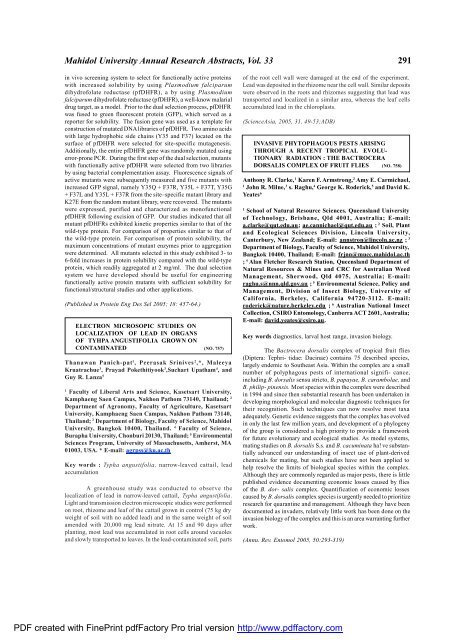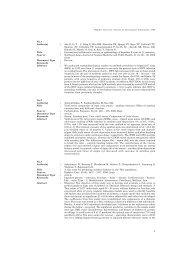Faculty of Science - Mahidol University
Faculty of Science - Mahidol University
Faculty of Science - Mahidol University
You also want an ePaper? Increase the reach of your titles
YUMPU automatically turns print PDFs into web optimized ePapers that Google loves.
<strong>Mahidol</strong> <strong>University</strong> Annual Research Abstracts, Vol. 33 291<br />
in vivo screening system to select for functionally active proteins<br />
with increased solubility by using Plasmodium falciparum<br />
dihydr<strong>of</strong>olate reductase (pfDHFR), a by using Plasmodium<br />
falciparum dihydr<strong>of</strong>olate reductase (pfDHFR), a well-know malarial<br />
drug target, as a model. Prior to the dual selection process, pfDHFR<br />
was fused to green fluorescent protein (GFP), which served as a<br />
reporter for solubility. The fusion gene was used as a template for<br />
construction <strong>of</strong> mutated DNA libraries <strong>of</strong> pfDHFR. Two amino acids<br />
with large hydrophobic side chains (Y35 and F37) located on the<br />
surface <strong>of</strong> pfDHFR were selected for site-specific mutagenesis.<br />
Additionally, the entire pfDHFR gene was randomly mutated using<br />
error-prone PCR. During the first step <strong>of</strong> the dual selection, mutants<br />
with functionally active pfDHFR were selected from two libraries<br />
by using bacterial complementation assay. Fluorescence signals <strong>of</strong><br />
active mutants were subsequently measured and five mutants with<br />
increased GFP signal, namely Y35Q + F37R, Y35L + F37T, Y35G<br />
+ F37L and Y35L + F37R from the site–specific mutant library and<br />
K27E from the random mutant library, were recovered. The mutants<br />
were expressed, purified and characterized as mon<strong>of</strong>unctional<br />
pfDHFR following excision <strong>of</strong> GFP. Our studies indicated that all<br />
mutant pfDHFRs exhibited kinetic properties similar to that <strong>of</strong> the<br />
wild-type protein. For comparison <strong>of</strong> properties similar to that <strong>of</strong><br />
the wild-type protein. For comparison <strong>of</strong> protein solubility, the<br />
maximum concentrations <strong>of</strong> mutant enzymes prior to aggregation<br />
were determined. All mutants selected in this study exhibited 3- to<br />
6-fold increases in protein solubility compared with the wild-type<br />
protein, which readily aggregated at 2 mg/ml. The dual selection<br />
system we have developed should be useful for engineering<br />
functionally active protein mutants with sufficient solubility for<br />
functional/structural studies and other applications.<br />
(Published in Protein Eng Des Sel 2005; 18: 457-64.)<br />
ELECTRON MICROSOPIC STUDIES ON<br />
LOCALIZATION OF LEAD IN ORGANS<br />
OF TYHPA ANGUSTIFOLIA GROWN ON<br />
CONTAMINATED (NO. 757)<br />
Thanawan Panich-pat 1 , Peerasak Srinives 2 ,*, Maleeya<br />
Kruatrachue 3 , Prayad Pokethitiyook 3 ,Suchart Upatham 4 , and<br />
Guy R. Lanza 5<br />
1 <strong>Faculty</strong> <strong>of</strong> Liberal Arts and <strong>Science</strong>, Kasetsart <strong>University</strong>,<br />
Kamphaeng Saen Campus, Nakhon Pathom 73140, Thailand; 2<br />
Department <strong>of</strong> Agronomy, <strong>Faculty</strong> <strong>of</strong> Agriculture, Kasetsart<br />
<strong>University</strong>, Kamphaeng Saen Campus, Nakhon Pathom 73140,<br />
Thailand; 3 Department <strong>of</strong> Biology, <strong>Faculty</strong> <strong>of</strong> <strong>Science</strong>, <strong>Mahidol</strong><br />
<strong>University</strong>, Bangkok 10400, Thailand. 4 <strong>Faculty</strong> <strong>of</strong> <strong>Science</strong>,<br />
Burapha <strong>University</strong>, Chonburi 20130, Thailand; 5 Environmental<br />
<strong>Science</strong>s Program, <strong>University</strong> <strong>of</strong> Massachusetts, Amherst, MA<br />
01003, USA. * E-mail: agrpss@ku.ac.th<br />
Key words : Typha angustifolia, narrow-leaved cattail, lead<br />
accumulation<br />
A greenhouse study was conducted to observe the<br />
localization <strong>of</strong> lead in narrow-leaved cattail, Typha angustifolia.<br />
Light and transmission electron microscopic studies were performed<br />
on root, rhizome and leaf <strong>of</strong> the cattail grown in control (75 kg dry<br />
weight <strong>of</strong> soil with no added lead) and in the same weight <strong>of</strong> soil<br />
amended with 20,000 mg lead nitrate. At 15 and 90 days after<br />
planting, most lead was accumulated in root cells around vacuoles<br />
and slowly transported to leaves. In the lead-contaminated soil, parts<br />
<strong>of</strong> the root cell wall were damaged at the end <strong>of</strong> the experiment.<br />
Lead was deposited in the rhizome near the cell wall. Similar deposits<br />
were observed in the roots and rhizomes suggesting that lead was<br />
transported and localized in a similar area, whereas the leaf cells<br />
accumulated lead in the chloroplasts.<br />
(<strong>Science</strong>Asia, 2005, 31, 49-53;ADB)<br />
INVASIVE PHYTOPHAGOUS PESTS ARISING<br />
THROUGH A RECENT TROPICAL EVOLU-<br />
TIONARY RADIATION : THE BACTROCERA<br />
DORSALIS COMPLEX OF FRUIT FLIES (NO. 758)<br />
Anthony R. Clarke, 1 Karen F. Armstrong, 2 Amy E. Carmichael,<br />
1 John R. Milne, 3 s. Raghu, 4 George K. Roderick, 5 and David K.<br />
Yeates 6<br />
1 School <strong>of</strong> Natural Resource <strong>Science</strong>s. Queensland <strong>University</strong><br />
<strong>of</strong> Technology, Brisbane, Qld 4001, Australia; E-mail:<br />
a.clarke@qut.edu.au; ae.cannichael@qut.edu.au ; 2 Soil, Plant<br />
and Ecological <strong>Science</strong>s Division, Lincoln <strong>University</strong>,<br />
Canterbury, New Zealand; E-mail: annstron@lincoln.ac.nz ; 3<br />
Department <strong>of</strong> Biology, <strong>Faculty</strong> <strong>of</strong> <strong>Science</strong>, <strong>Mahidol</strong> <strong>University</strong>,<br />
Bangkok 10400, Thailand; E-mail: frjnn@mucc.mahidol.ac.th<br />
; 4 Alan Fletcher Research Station, Queensland Department <strong>of</strong><br />
Natural Resources & Mines and CRC for Australian Weed<br />
Management, Sherwood, Qld 4075, Australia; E-mail:<br />
raghu.s@nnn.qld.gov.au ; 5 Environmental <strong>Science</strong>, Policy and<br />
Management, Division <strong>of</strong> Insect Biology, <strong>University</strong> <strong>of</strong><br />
California, Berkeley, California 94720-3112. E-mail:<br />
roderick@nature.berkeley.edu ; 6 Australian National Insect<br />
Collection, CSIRO Entomology, Canberra ACT 2601, Australia;<br />
E-mail: david.yeates@csiro.au.<br />
Key words diagnostics, larval host range, invasion biology.<br />
The Bactrocera dorsalis complex <strong>of</strong> tropical fruit flies<br />
(Diptera: Tephri- tidae: Dacinae) contains 75 described species,<br />
largely endemic to Southeast Asia. Within the complex are a small<br />
number <strong>of</strong> polyphagous pests <strong>of</strong> international signifi- cance,<br />
including B. dorsalis sensu stricto, B. papayae, B. carambolae, and<br />
B. philip- pinensis. Most species within the complex were described<br />
in 1994 and since then substantial research has been undertaken in<br />
developing morphological and molecular diagnostic techniques for<br />
their recognition. Such techniques can now resolve most taxa<br />
adequately. Genetic evidence suggests that the complex has evolved<br />
in only the last few million years, and development <strong>of</strong> a phylogeny<br />
<strong>of</strong> the group is considered a high priority to provide a framework<br />
for future evolutionary and ecological studies. As model systems,<br />
mating studies on B. dorsalis S.s. and B. cacuminata ha! ve substantially<br />
advanced our understanding <strong>of</strong> insect use <strong>of</strong> plant-derived<br />
chemicals for mating, but such studies have not been applied to<br />
help resolve the limits <strong>of</strong> biological species within the complex.<br />
Although they are commonly regarded as major pests, there is little<br />
published evidence documenting economic losses caused by flies<br />
<strong>of</strong> the B. dor- salis complex. Quantification <strong>of</strong> economic losses<br />
caused by B. dorsalis complex species is urgently needed to prioritize<br />
research for quarantine and management. Although they have been<br />
documented as invaders, relatively little work has been done on the<br />
invasion biology <strong>of</strong> the complex and this is an area warranting further<br />
work.<br />
(Annu. Rev. Entomol 2005, 50:293-319)<br />
PDF created with FinePrint pdfFactory Pro trial version http://www.pdffactory.com
















